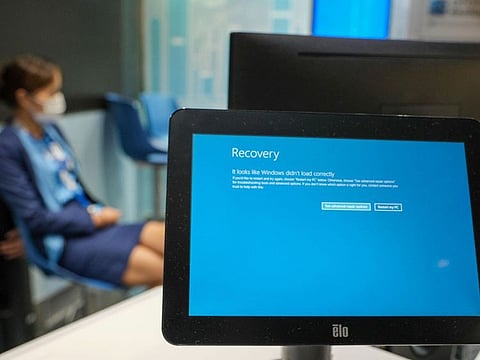Microsoft global outage: What’s CrowdStrike, and how does it affect you?
US cybersecurity firm has offered a manual fix for Windows computers with blue screen

The global computer outage that crippled airports, businesses, financial firms, airlines, media, telecom and emergency services seemed to stem partly from a software update issued by major US cybersecurity firm CrowdStrike, reports said.
The exact cause of the widespread Microsoft outage on July 19, 2024, remains unclear. However, Microsoft said it is taking “mitigation action” to deal with “the lingering impact” of the outage.
Microsoft said they had traced the outage to a configuration change in Azure backend workloads, but some businesses and Australia’s home affairs ministry said the outage seems to be linked to a Crowdstrike security update.
What’s CrowdStrike?
CrowdStrike is an American cybersecurity technology company based in Austin, Texas, which provides protection for people, processes and technologies. It offers cloud workload protection and Endpoint Detection and Response (EDR) — an endpoint security solution that continuously monitors end-user devices to detect and respond to cyber threats like ransomware and malware.
What is the CrowdStrike software?
CrowdStrike software is designed to protect Windows systems from cyberattacks by detecting viruses, malware, and hacking attempts. If CrowdStrike is installed on a computer, it runs soon after the PC is powered on.
What’s the CrowdStrike issue?
Some reports said a glitch in the software update from Crowdstrike was the source of the problem. It affected Windows devices, leading to the dreaded “blue screen of death (BSOD)” on PCs.
CrowdStrike integrates with Windows to provide advanced security, using cloud-based AI and machine learning to detect and prevent threats in real-time. In this case, after a faulty update, a piece of software called Falcon Sensor caused Windows to fail on startup.
What did CrowdStrike say about the outage?
CrowdStrike admitted that the outages were caused by a defect in a single content update of its software on Microsoft Windows operating systems. CEO George Kurtz confirmed this in a post on X.
According to an advisory, the issue is specific to Falcon, one of CrowdStrike’s main software products, and does not impact Mac or Linux operating systems.
Only computers running Microsoft Windows are crashing after the software update issued by CrowdStrike, allaying fears of a cyberattack. In his X post, Kurtz said the issue was identified and isolated, and engineers are trying to fix it.
What’s the UAE advisory?
The UAE’s Telecommunications and Digital Government Regulatory Authority advised computer users of a “technical defect” with CrowdStrike.
“We advise users of the program to be patient and not perform any updates or downloads of CrowdStrike software until the problem is resolved,” it said in a statement.
How does the CrowdStrike issue affect you?
Are you facing a blue screen on your Microsoft Windows 10? You could be one of the millions of computer users worldwide experiencing the Blue Screen of Death (BSOD) error, which suddenly causes the systems to shut down or restart.
How can you fix the CrowdStrike blue screen?
CrowdStrike has offered a simple fix for the glitch in the software suite Falcon Sensor, which maintains system cyber security. The company also provided a manual solution in a note to its customers.
It says:
1. Boot Windows into Safe Mode or WRE.
2. Go to C:\Windows\System32\drivers\CrowdStrike
3. Locate and delete the file matching “C-00000291*.sys”
4. Boot normally.
CrowdStrike and Microsoft are expected to issue a proper fix after a while.
What’s Microsoft’s explanation?
Microsoft said the outage started with their customers experiencing issues with multiple Azure services. Azure is a cloud computing platform that provides services for building, deploying, and managing applications and services.
Microsoft traced the outage to a configuration change in Azure backend workloads. This change caused connectivity failures between storage and compute resources, affecting downstream Microsoft 365 services, a note on the company website said.
Sign up for the Daily Briefing
Get the latest news and updates straight to your inbox



